Report: Economic Analysis of Sainsbury's and Product Elasticity
VerifiedAdded on 2023/01/07
|11
|3353
|97
Report
AI Summary
This report analyzes Sainsbury's, a prominent retail company in the United Kingdom, focusing on its 'Taste the Difference' product range. The introduction outlines the company's history and market presence. The main body delves into picking the specific product segment and examines factors influencing demand and market equilibrium, including the price of substitutes and complements, consumer income, taste, expectations, and demographics. The analysis further explores the impact of substitution and income effects on price elasticity of demand, highlighting how these factors affect consumer behavior. The report concludes by summarizing the key findings regarding the economic dynamics of Sainsbury's product offerings and their responsiveness to market forces. The report provides a detailed overview of the content.
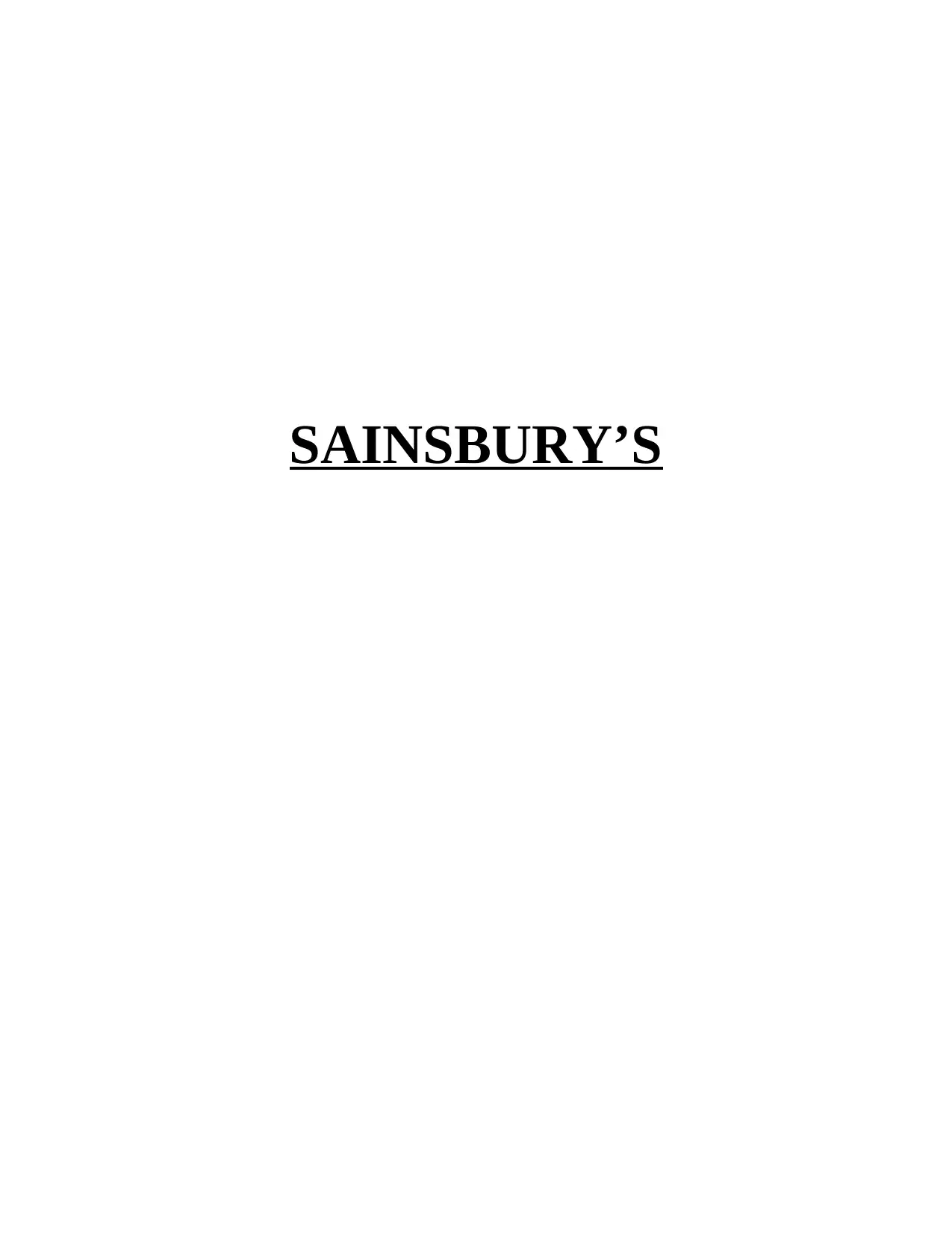
SAINSBURY’S
Paraphrase This Document
Need a fresh take? Get an instant paraphrase of this document with our AI Paraphraser
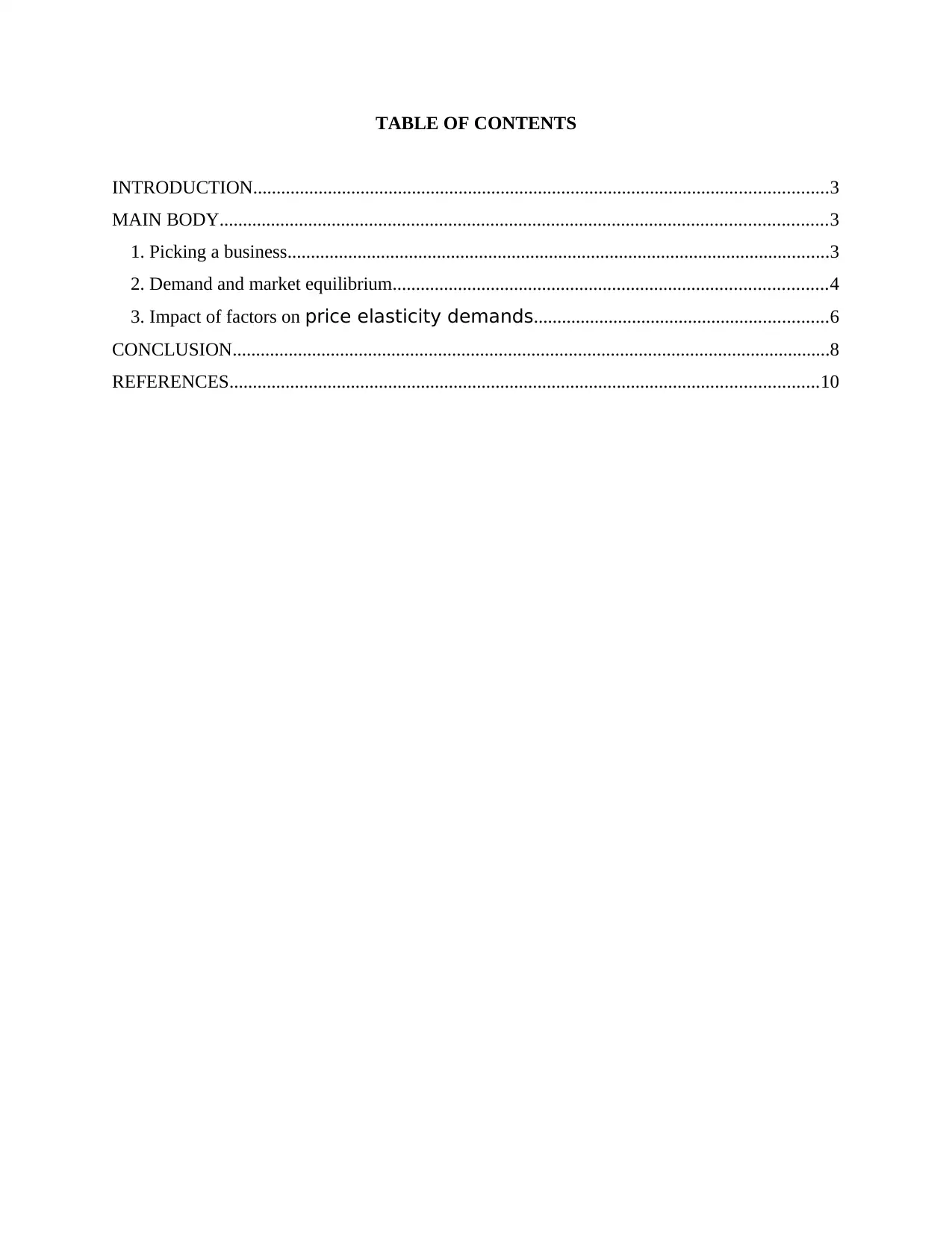
TABLE OF CONTENTS
INTRODUCTION...........................................................................................................................3
MAIN BODY..................................................................................................................................3
1. Picking a business....................................................................................................................3
2. Demand and market equilibrium.............................................................................................4
3. Impact of factors on price elasticity demands...............................................................6
CONCLUSION................................................................................................................................8
REFERENCES..............................................................................................................................10
INTRODUCTION...........................................................................................................................3
MAIN BODY..................................................................................................................................3
1. Picking a business....................................................................................................................3
2. Demand and market equilibrium.............................................................................................4
3. Impact of factors on price elasticity demands...............................................................6
CONCLUSION................................................................................................................................8
REFERENCES..............................................................................................................................10
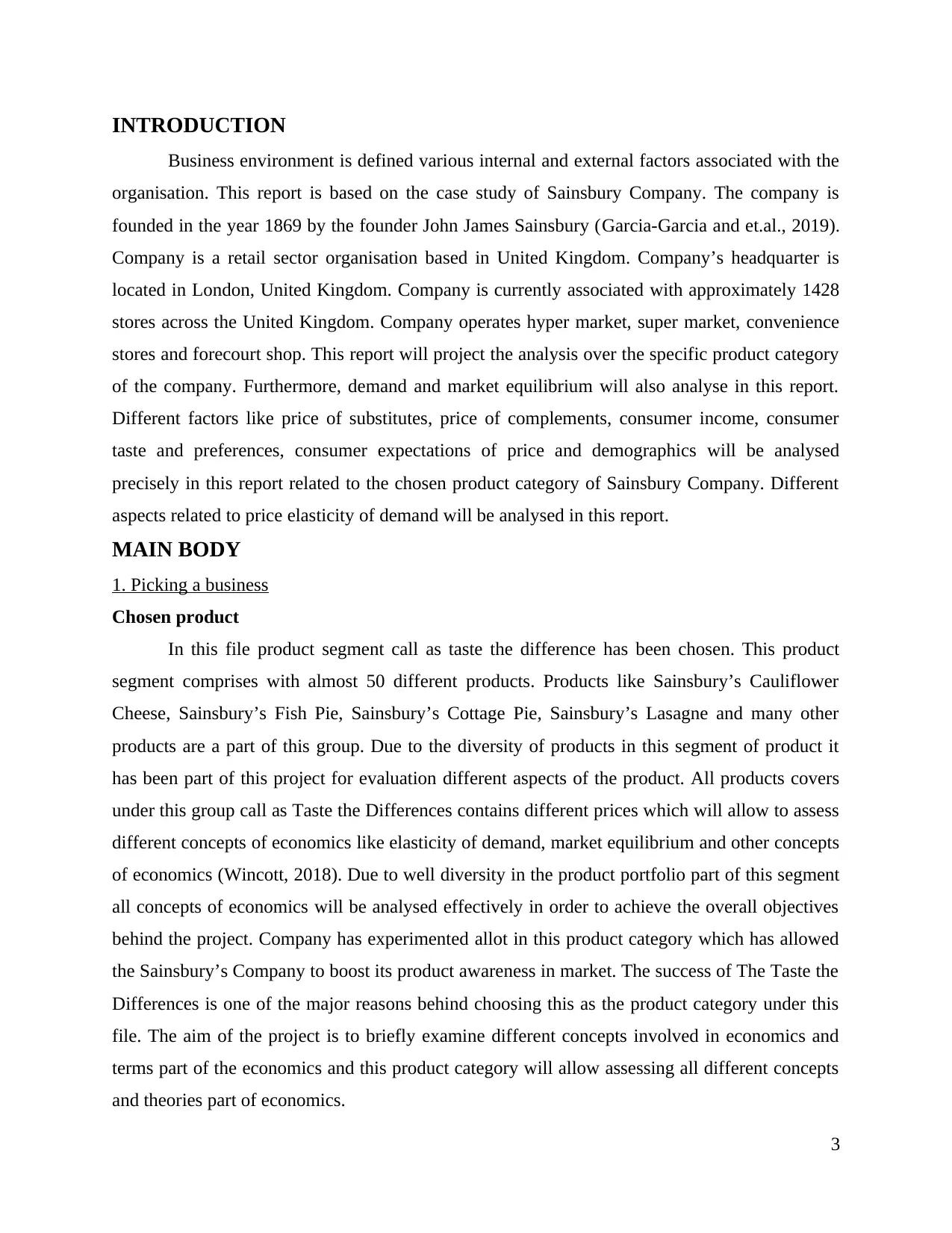
INTRODUCTION
Business environment is defined various internal and external factors associated with the
organisation. This report is based on the case study of Sainsbury Company. The company is
founded in the year 1869 by the founder John James Sainsbury (Garcia-Garcia and et.al., 2019).
Company is a retail sector organisation based in United Kingdom. Company’s headquarter is
located in London, United Kingdom. Company is currently associated with approximately 1428
stores across the United Kingdom. Company operates hyper market, super market, convenience
stores and forecourt shop. This report will project the analysis over the specific product category
of the company. Furthermore, demand and market equilibrium will also analyse in this report.
Different factors like price of substitutes, price of complements, consumer income, consumer
taste and preferences, consumer expectations of price and demographics will be analysed
precisely in this report related to the chosen product category of Sainsbury Company. Different
aspects related to price elasticity of demand will be analysed in this report.
MAIN BODY
1. Picking a business
Chosen product
In this file product segment call as taste the difference has been chosen. This product
segment comprises with almost 50 different products. Products like Sainsbury’s Cauliflower
Cheese, Sainsbury’s Fish Pie, Sainsbury’s Cottage Pie, Sainsbury’s Lasagne and many other
products are a part of this group. Due to the diversity of products in this segment of product it
has been part of this project for evaluation different aspects of the product. All products covers
under this group call as Taste the Differences contains different prices which will allow to assess
different concepts of economics like elasticity of demand, market equilibrium and other concepts
of economics (Wincott, 2018). Due to well diversity in the product portfolio part of this segment
all concepts of economics will be analysed effectively in order to achieve the overall objectives
behind the project. Company has experimented allot in this product category which has allowed
the Sainsbury’s Company to boost its product awareness in market. The success of The Taste the
Differences is one of the major reasons behind choosing this as the product category under this
file. The aim of the project is to briefly examine different concepts involved in economics and
terms part of the economics and this product category will allow assessing all different concepts
and theories part of economics.
3
Business environment is defined various internal and external factors associated with the
organisation. This report is based on the case study of Sainsbury Company. The company is
founded in the year 1869 by the founder John James Sainsbury (Garcia-Garcia and et.al., 2019).
Company is a retail sector organisation based in United Kingdom. Company’s headquarter is
located in London, United Kingdom. Company is currently associated with approximately 1428
stores across the United Kingdom. Company operates hyper market, super market, convenience
stores and forecourt shop. This report will project the analysis over the specific product category
of the company. Furthermore, demand and market equilibrium will also analyse in this report.
Different factors like price of substitutes, price of complements, consumer income, consumer
taste and preferences, consumer expectations of price and demographics will be analysed
precisely in this report related to the chosen product category of Sainsbury Company. Different
aspects related to price elasticity of demand will be analysed in this report.
MAIN BODY
1. Picking a business
Chosen product
In this file product segment call as taste the difference has been chosen. This product
segment comprises with almost 50 different products. Products like Sainsbury’s Cauliflower
Cheese, Sainsbury’s Fish Pie, Sainsbury’s Cottage Pie, Sainsbury’s Lasagne and many other
products are a part of this group. Due to the diversity of products in this segment of product it
has been part of this project for evaluation different aspects of the product. All products covers
under this group call as Taste the Differences contains different prices which will allow to assess
different concepts of economics like elasticity of demand, market equilibrium and other concepts
of economics (Wincott, 2018). Due to well diversity in the product portfolio part of this segment
all concepts of economics will be analysed effectively in order to achieve the overall objectives
behind the project. Company has experimented allot in this product category which has allowed
the Sainsbury’s Company to boost its product awareness in market. The success of The Taste the
Differences is one of the major reasons behind choosing this as the product category under this
file. The aim of the project is to briefly examine different concepts involved in economics and
terms part of the economics and this product category will allow assessing all different concepts
and theories part of economics.
3
⊘ This is a preview!⊘
Do you want full access?
Subscribe today to unlock all pages.

Trusted by 1+ million students worldwide
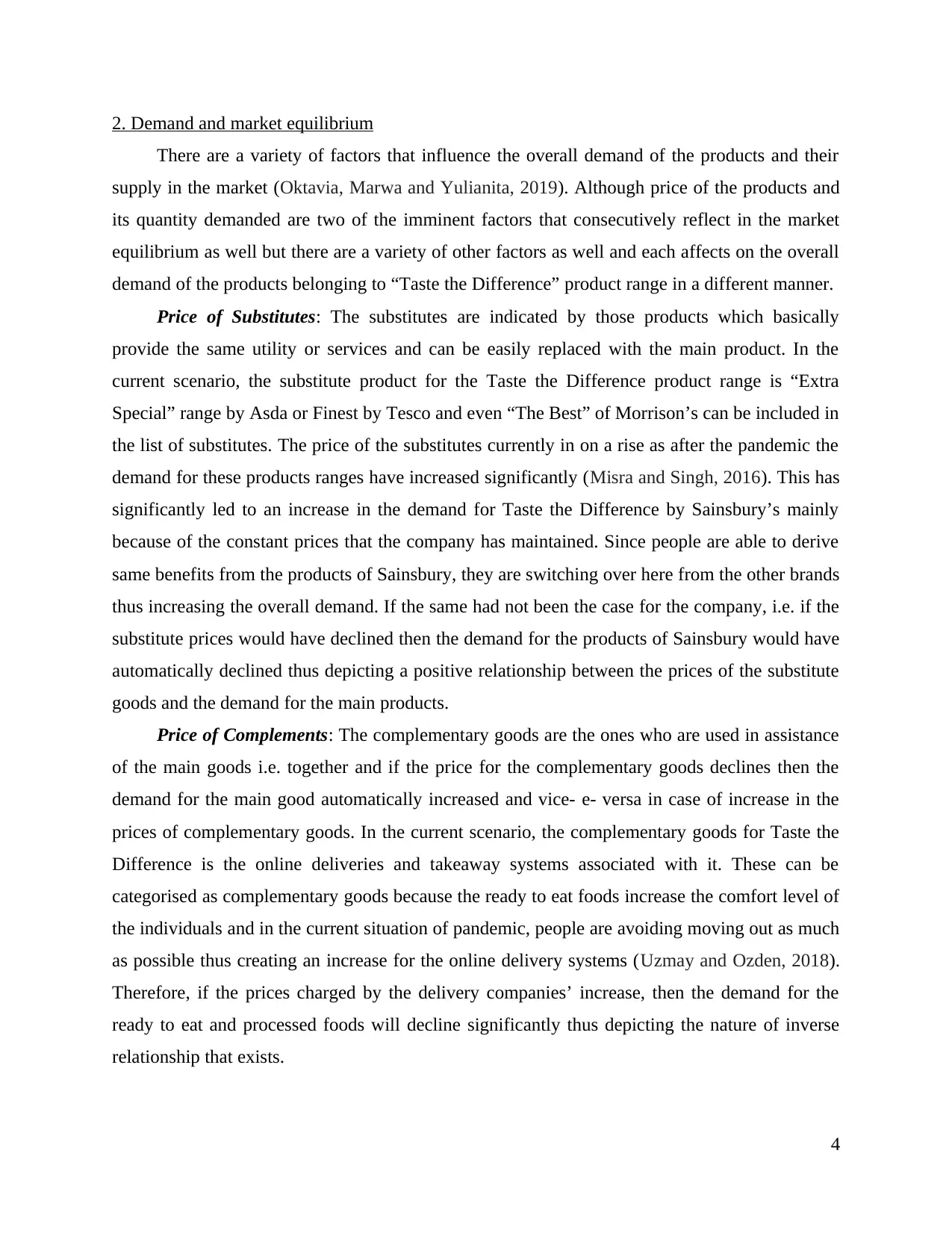
2. Demand and market equilibrium
There are a variety of factors that influence the overall demand of the products and their
supply in the market (Oktavia, Marwa and Yulianita, 2019). Although price of the products and
its quantity demanded are two of the imminent factors that consecutively reflect in the market
equilibrium as well but there are a variety of other factors as well and each affects on the overall
demand of the products belonging to “Taste the Difference” product range in a different manner.
Price of Substitutes: The substitutes are indicated by those products which basically
provide the same utility or services and can be easily replaced with the main product. In the
current scenario, the substitute product for the Taste the Difference product range is “Extra
Special” range by Asda or Finest by Tesco and even “The Best” of Morrison’s can be included in
the list of substitutes. The price of the substitutes currently in on a rise as after the pandemic the
demand for these products ranges have increased significantly (Misra and Singh, 2016). This has
significantly led to an increase in the demand for Taste the Difference by Sainsbury’s mainly
because of the constant prices that the company has maintained. Since people are able to derive
same benefits from the products of Sainsbury, they are switching over here from the other brands
thus increasing the overall demand. If the same had not been the case for the company, i.e. if the
substitute prices would have declined then the demand for the products of Sainsbury would have
automatically declined thus depicting a positive relationship between the prices of the substitute
goods and the demand for the main products.
Price of Complements: The complementary goods are the ones who are used in assistance
of the main goods i.e. together and if the price for the complementary goods declines then the
demand for the main good automatically increased and vice- e- versa in case of increase in the
prices of complementary goods. In the current scenario, the complementary goods for Taste the
Difference is the online deliveries and takeaway systems associated with it. These can be
categorised as complementary goods because the ready to eat foods increase the comfort level of
the individuals and in the current situation of pandemic, people are avoiding moving out as much
as possible thus creating an increase for the online delivery systems (Uzmay and Ozden, 2018).
Therefore, if the prices charged by the delivery companies’ increase, then the demand for the
ready to eat and processed foods will decline significantly thus depicting the nature of inverse
relationship that exists.
4
There are a variety of factors that influence the overall demand of the products and their
supply in the market (Oktavia, Marwa and Yulianita, 2019). Although price of the products and
its quantity demanded are two of the imminent factors that consecutively reflect in the market
equilibrium as well but there are a variety of other factors as well and each affects on the overall
demand of the products belonging to “Taste the Difference” product range in a different manner.
Price of Substitutes: The substitutes are indicated by those products which basically
provide the same utility or services and can be easily replaced with the main product. In the
current scenario, the substitute product for the Taste the Difference product range is “Extra
Special” range by Asda or Finest by Tesco and even “The Best” of Morrison’s can be included in
the list of substitutes. The price of the substitutes currently in on a rise as after the pandemic the
demand for these products ranges have increased significantly (Misra and Singh, 2016). This has
significantly led to an increase in the demand for Taste the Difference by Sainsbury’s mainly
because of the constant prices that the company has maintained. Since people are able to derive
same benefits from the products of Sainsbury, they are switching over here from the other brands
thus increasing the overall demand. If the same had not been the case for the company, i.e. if the
substitute prices would have declined then the demand for the products of Sainsbury would have
automatically declined thus depicting a positive relationship between the prices of the substitute
goods and the demand for the main products.
Price of Complements: The complementary goods are the ones who are used in assistance
of the main goods i.e. together and if the price for the complementary goods declines then the
demand for the main good automatically increased and vice- e- versa in case of increase in the
prices of complementary goods. In the current scenario, the complementary goods for Taste the
Difference is the online deliveries and takeaway systems associated with it. These can be
categorised as complementary goods because the ready to eat foods increase the comfort level of
the individuals and in the current situation of pandemic, people are avoiding moving out as much
as possible thus creating an increase for the online delivery systems (Uzmay and Ozden, 2018).
Therefore, if the prices charged by the delivery companies’ increase, then the demand for the
ready to eat and processed foods will decline significantly thus depicting the nature of inverse
relationship that exists.
4
Paraphrase This Document
Need a fresh take? Get an instant paraphrase of this document with our AI Paraphraser
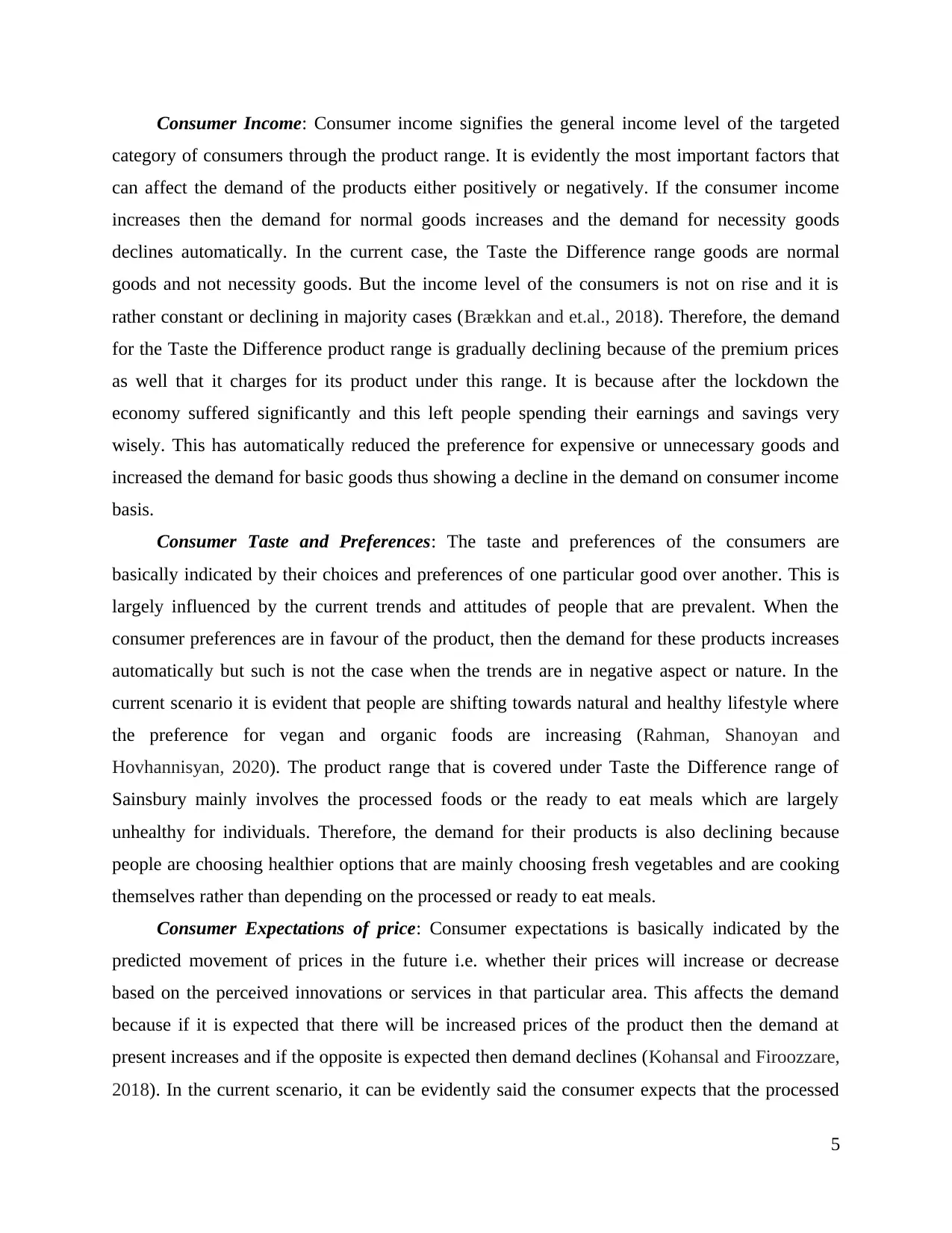
Consumer Income: Consumer income signifies the general income level of the targeted
category of consumers through the product range. It is evidently the most important factors that
can affect the demand of the products either positively or negatively. If the consumer income
increases then the demand for normal goods increases and the demand for necessity goods
declines automatically. In the current case, the Taste the Difference range goods are normal
goods and not necessity goods. But the income level of the consumers is not on rise and it is
rather constant or declining in majority cases (Brækkan and et.al., 2018). Therefore, the demand
for the Taste the Difference product range is gradually declining because of the premium prices
as well that it charges for its product under this range. It is because after the lockdown the
economy suffered significantly and this left people spending their earnings and savings very
wisely. This has automatically reduced the preference for expensive or unnecessary goods and
increased the demand for basic goods thus showing a decline in the demand on consumer income
basis.
Consumer Taste and Preferences: The taste and preferences of the consumers are
basically indicated by their choices and preferences of one particular good over another. This is
largely influenced by the current trends and attitudes of people that are prevalent. When the
consumer preferences are in favour of the product, then the demand for these products increases
automatically but such is not the case when the trends are in negative aspect or nature. In the
current scenario it is evident that people are shifting towards natural and healthy lifestyle where
the preference for vegan and organic foods are increasing (Rahman, Shanoyan and
Hovhannisyan, 2020). The product range that is covered under Taste the Difference range of
Sainsbury mainly involves the processed foods or the ready to eat meals which are largely
unhealthy for individuals. Therefore, the demand for their products is also declining because
people are choosing healthier options that are mainly choosing fresh vegetables and are cooking
themselves rather than depending on the processed or ready to eat meals.
Consumer Expectations of price: Consumer expectations is basically indicated by the
predicted movement of prices in the future i.e. whether their prices will increase or decrease
based on the perceived innovations or services in that particular area. This affects the demand
because if it is expected that there will be increased prices of the product then the demand at
present increases and if the opposite is expected then demand declines (Kohansal and Firoozzare,
2018). In the current scenario, it can be evidently said the consumer expects that the processed
5
category of consumers through the product range. It is evidently the most important factors that
can affect the demand of the products either positively or negatively. If the consumer income
increases then the demand for normal goods increases and the demand for necessity goods
declines automatically. In the current case, the Taste the Difference range goods are normal
goods and not necessity goods. But the income level of the consumers is not on rise and it is
rather constant or declining in majority cases (Brækkan and et.al., 2018). Therefore, the demand
for the Taste the Difference product range is gradually declining because of the premium prices
as well that it charges for its product under this range. It is because after the lockdown the
economy suffered significantly and this left people spending their earnings and savings very
wisely. This has automatically reduced the preference for expensive or unnecessary goods and
increased the demand for basic goods thus showing a decline in the demand on consumer income
basis.
Consumer Taste and Preferences: The taste and preferences of the consumers are
basically indicated by their choices and preferences of one particular good over another. This is
largely influenced by the current trends and attitudes of people that are prevalent. When the
consumer preferences are in favour of the product, then the demand for these products increases
automatically but such is not the case when the trends are in negative aspect or nature. In the
current scenario it is evident that people are shifting towards natural and healthy lifestyle where
the preference for vegan and organic foods are increasing (Rahman, Shanoyan and
Hovhannisyan, 2020). The product range that is covered under Taste the Difference range of
Sainsbury mainly involves the processed foods or the ready to eat meals which are largely
unhealthy for individuals. Therefore, the demand for their products is also declining because
people are choosing healthier options that are mainly choosing fresh vegetables and are cooking
themselves rather than depending on the processed or ready to eat meals.
Consumer Expectations of price: Consumer expectations is basically indicated by the
predicted movement of prices in the future i.e. whether their prices will increase or decrease
based on the perceived innovations or services in that particular area. This affects the demand
because if it is expected that there will be increased prices of the product then the demand at
present increases and if the opposite is expected then demand declines (Kohansal and Firoozzare,
2018). In the current scenario, it can be evidently said the consumer expects that the processed
5
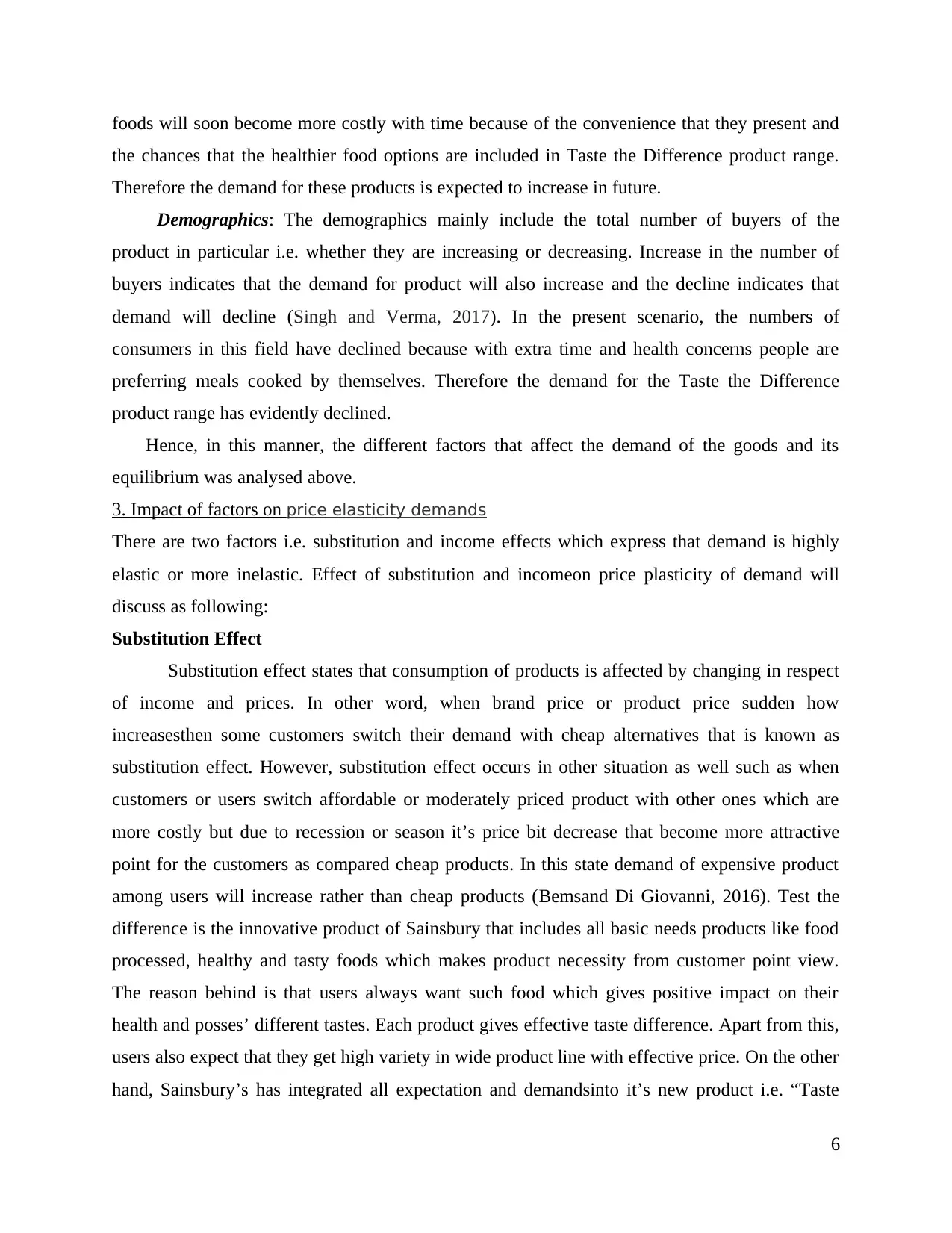
foods will soon become more costly with time because of the convenience that they present and
the chances that the healthier food options are included in Taste the Difference product range.
Therefore the demand for these products is expected to increase in future.
Demographics: The demographics mainly include the total number of buyers of the
product in particular i.e. whether they are increasing or decreasing. Increase in the number of
buyers indicates that the demand for product will also increase and the decline indicates that
demand will decline (Singh and Verma, 2017). In the present scenario, the numbers of
consumers in this field have declined because with extra time and health concerns people are
preferring meals cooked by themselves. Therefore the demand for the Taste the Difference
product range has evidently declined.
Hence, in this manner, the different factors that affect the demand of the goods and its
equilibrium was analysed above.
3. Impact of factors on price elasticity demands
There are two factors i.e. substitution and income effects which express that demand is highly
elastic or more inelastic. Effect of substitution and incomeon price plasticity of demand will
discuss as following:
Substitution Effect
Substitution effect states that consumption of products is affected by changing in respect
of income and prices. In other word, when brand price or product price sudden how
increasesthen some customers switch their demand with cheap alternatives that is known as
substitution effect. However, substitution effect occurs in other situation as well such as when
customers or users switch affordable or moderately priced product with other ones which are
more costly but due to recession or season it’s price bit decrease that become more attractive
point for the customers as compared cheap products. In this state demand of expensive product
among users will increase rather than cheap products (Bemsand Di Giovanni, 2016). Test the
difference is the innovative product of Sainsbury that includes all basic needs products like food
processed, healthy and tasty foods which makes product necessity from customer point view.
The reason behind is that users always want such food which gives positive impact on their
health and posses’ different tastes. Each product gives effective taste difference. Apart from this,
users also expect that they get high variety in wide product line with effective price. On the other
hand, Sainsbury’s has integrated all expectation and demandsinto it’s new product i.e. “Taste
6
the chances that the healthier food options are included in Taste the Difference product range.
Therefore the demand for these products is expected to increase in future.
Demographics: The demographics mainly include the total number of buyers of the
product in particular i.e. whether they are increasing or decreasing. Increase in the number of
buyers indicates that the demand for product will also increase and the decline indicates that
demand will decline (Singh and Verma, 2017). In the present scenario, the numbers of
consumers in this field have declined because with extra time and health concerns people are
preferring meals cooked by themselves. Therefore the demand for the Taste the Difference
product range has evidently declined.
Hence, in this manner, the different factors that affect the demand of the goods and its
equilibrium was analysed above.
3. Impact of factors on price elasticity demands
There are two factors i.e. substitution and income effects which express that demand is highly
elastic or more inelastic. Effect of substitution and incomeon price plasticity of demand will
discuss as following:
Substitution Effect
Substitution effect states that consumption of products is affected by changing in respect
of income and prices. In other word, when brand price or product price sudden how
increasesthen some customers switch their demand with cheap alternatives that is known as
substitution effect. However, substitution effect occurs in other situation as well such as when
customers or users switch affordable or moderately priced product with other ones which are
more costly but due to recession or season it’s price bit decrease that become more attractive
point for the customers as compared cheap products. In this state demand of expensive product
among users will increase rather than cheap products (Bemsand Di Giovanni, 2016). Test the
difference is the innovative product of Sainsbury that includes all basic needs products like food
processed, healthy and tasty foods which makes product necessity from customer point view.
The reason behind is that users always want such food which gives positive impact on their
health and posses’ different tastes. Each product gives effective taste difference. Apart from this,
users also expect that they get high variety in wide product line with effective price. On the other
hand, Sainsbury’s has integrated all expectation and demandsinto it’s new product i.e. “Taste
6
⊘ This is a preview!⊘
Do you want full access?
Subscribe today to unlock all pages.

Trusted by 1+ million students worldwide
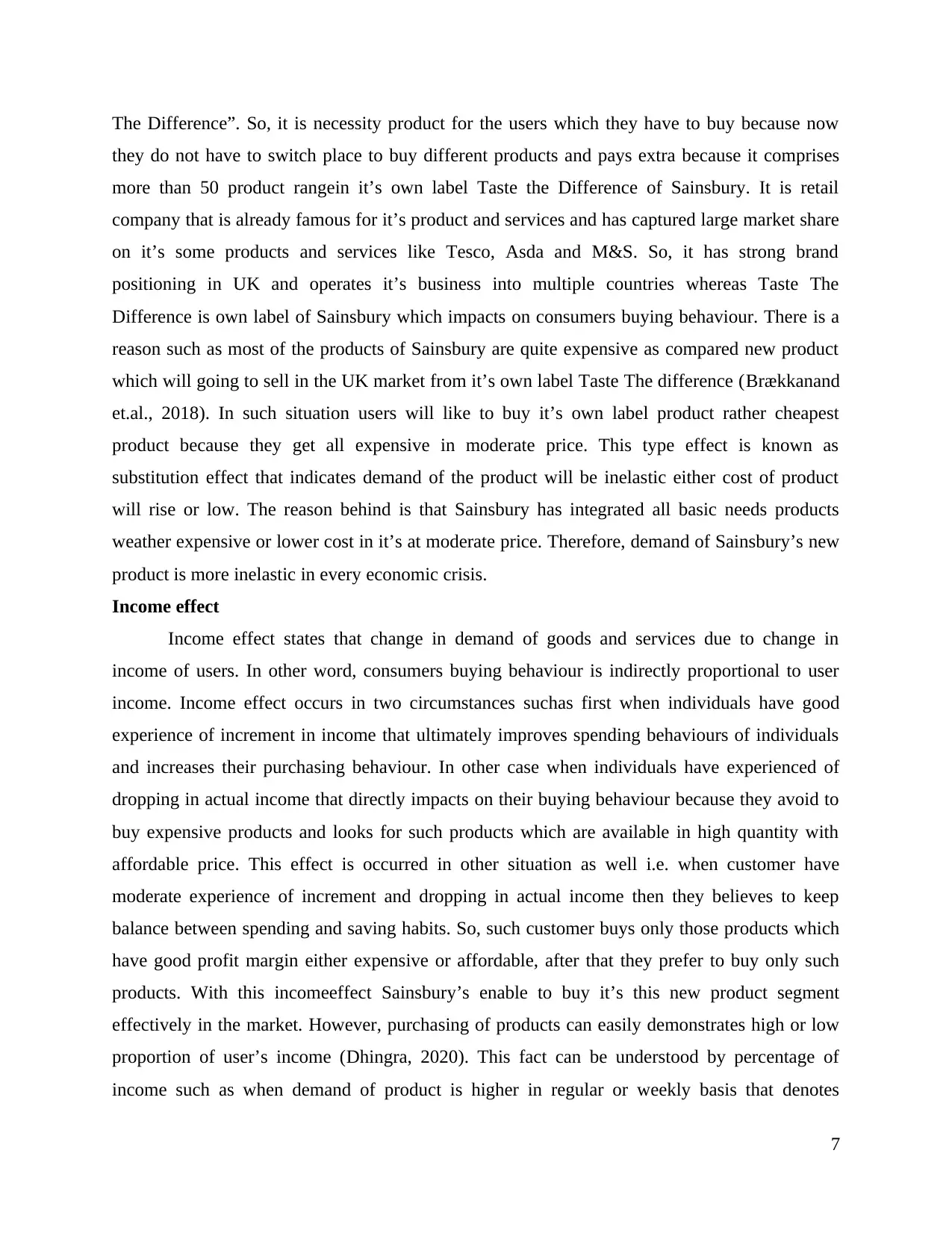
The Difference”. So, it is necessity product for the users which they have to buy because now
they do not have to switch place to buy different products and pays extra because it comprises
more than 50 product rangein it’s own label Taste the Difference of Sainsbury. It is retail
company that is already famous for it’s product and services and has captured large market share
on it’s some products and services like Tesco, Asda and M&S. So, it has strong brand
positioning in UK and operates it’s business into multiple countries whereas Taste The
Difference is own label of Sainsbury which impacts on consumers buying behaviour. There is a
reason such as most of the products of Sainsbury are quite expensive as compared new product
which will going to sell in the UK market from it’s own label Taste The difference (Brækkanand
et.al., 2018). In such situation users will like to buy it’s own label product rather cheapest
product because they get all expensive in moderate price. This type effect is known as
substitution effect that indicates demand of the product will be inelastic either cost of product
will rise or low. The reason behind is that Sainsbury has integrated all basic needs products
weather expensive or lower cost in it’s at moderate price. Therefore, demand of Sainsbury’s new
product is more inelastic in every economic crisis.
Income effect
Income effect states that change in demand of goods and services due to change in
income of users. In other word, consumers buying behaviour is indirectly proportional to user
income. Income effect occurs in two circumstances suchas first when individuals have good
experience of increment in income that ultimately improves spending behaviours of individuals
and increases their purchasing behaviour. In other case when individuals have experienced of
dropping in actual income that directly impacts on their buying behaviour because they avoid to
buy expensive products and looks for such products which are available in high quantity with
affordable price. This effect is occurred in other situation as well i.e. when customer have
moderate experience of increment and dropping in actual income then they believes to keep
balance between spending and saving habits. So, such customer buys only those products which
have good profit margin either expensive or affordable, after that they prefer to buy only such
products. With this incomeeffect Sainsbury’s enable to buy it’s this new product segment
effectively in the market. However, purchasing of products can easily demonstrates high or low
proportion of user’s income (Dhingra, 2020). This fact can be understood by percentage of
income such as when demand of product is higher in regular or weekly basis that denotes
7
they do not have to switch place to buy different products and pays extra because it comprises
more than 50 product rangein it’s own label Taste the Difference of Sainsbury. It is retail
company that is already famous for it’s product and services and has captured large market share
on it’s some products and services like Tesco, Asda and M&S. So, it has strong brand
positioning in UK and operates it’s business into multiple countries whereas Taste The
Difference is own label of Sainsbury which impacts on consumers buying behaviour. There is a
reason such as most of the products of Sainsbury are quite expensive as compared new product
which will going to sell in the UK market from it’s own label Taste The difference (Brækkanand
et.al., 2018). In such situation users will like to buy it’s own label product rather cheapest
product because they get all expensive in moderate price. This type effect is known as
substitution effect that indicates demand of the product will be inelastic either cost of product
will rise or low. The reason behind is that Sainsbury has integrated all basic needs products
weather expensive or lower cost in it’s at moderate price. Therefore, demand of Sainsbury’s new
product is more inelastic in every economic crisis.
Income effect
Income effect states that change in demand of goods and services due to change in
income of users. In other word, consumers buying behaviour is indirectly proportional to user
income. Income effect occurs in two circumstances suchas first when individuals have good
experience of increment in income that ultimately improves spending behaviours of individuals
and increases their purchasing behaviour. In other case when individuals have experienced of
dropping in actual income that directly impacts on their buying behaviour because they avoid to
buy expensive products and looks for such products which are available in high quantity with
affordable price. This effect is occurred in other situation as well i.e. when customer have
moderate experience of increment and dropping in actual income then they believes to keep
balance between spending and saving habits. So, such customer buys only those products which
have good profit margin either expensive or affordable, after that they prefer to buy only such
products. With this incomeeffect Sainsbury’s enable to buy it’s this new product segment
effectively in the market. However, purchasing of products can easily demonstrates high or low
proportion of user’s income (Dhingra, 2020). This fact can be understood by percentage of
income such as when demand of product is higher in regular or weekly basis that denotes
7
Paraphrase This Document
Need a fresh take? Get an instant paraphrase of this document with our AI Paraphraser
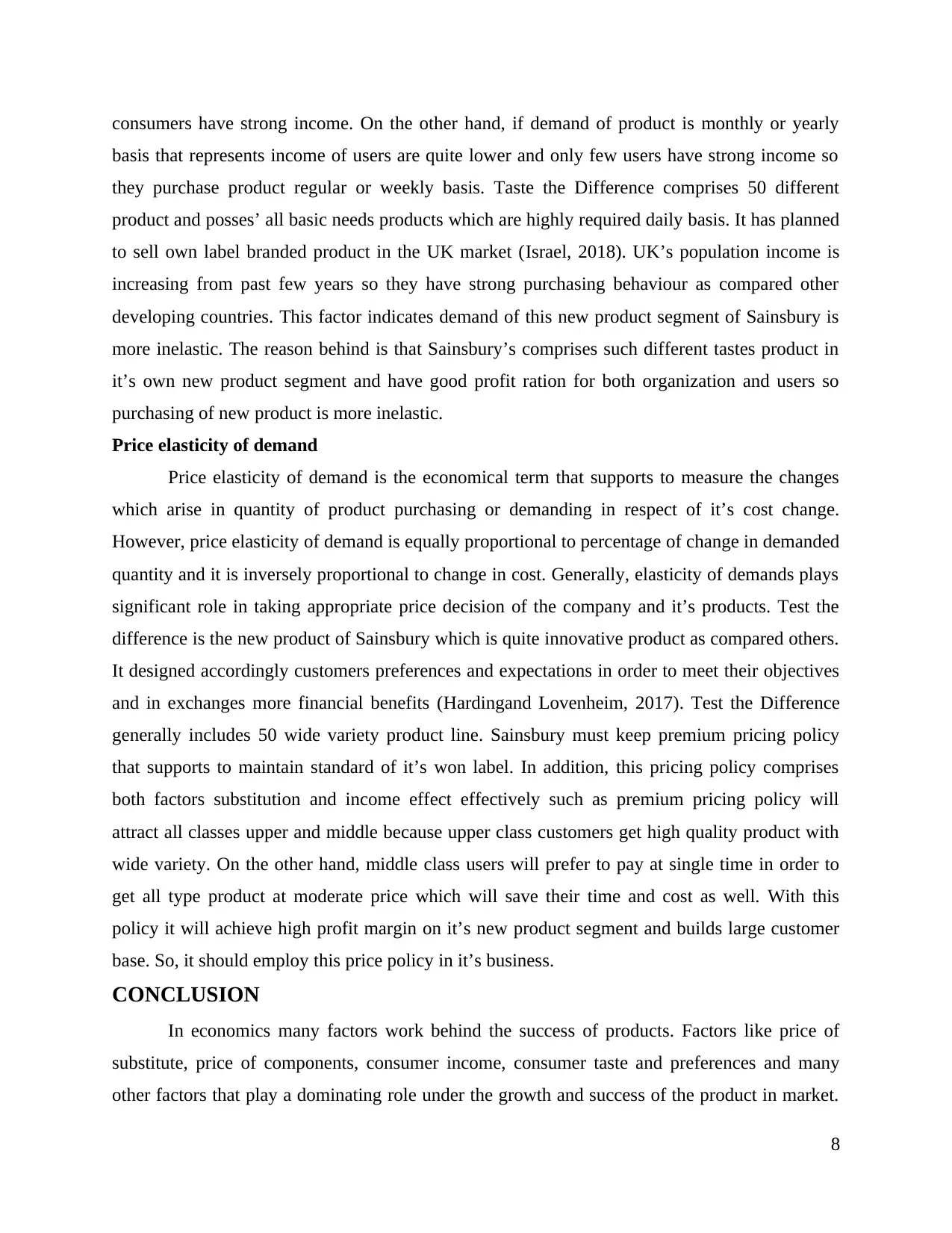
consumers have strong income. On the other hand, if demand of product is monthly or yearly
basis that represents income of users are quite lower and only few users have strong income so
they purchase product regular or weekly basis. Taste the Difference comprises 50 different
product and posses’ all basic needs products which are highly required daily basis. It has planned
to sell own label branded product in the UK market (Israel, 2018). UK’s population income is
increasing from past few years so they have strong purchasing behaviour as compared other
developing countries. This factor indicates demand of this new product segment of Sainsbury is
more inelastic. The reason behind is that Sainsbury’s comprises such different tastes product in
it’s own new product segment and have good profit ration for both organization and users so
purchasing of new product is more inelastic.
Price elasticity of demand
Price elasticity of demand is the economical term that supports to measure the changes
which arise in quantity of product purchasing or demanding in respect of it’s cost change.
However, price elasticity of demand is equally proportional to percentage of change in demanded
quantity and it is inversely proportional to change in cost. Generally, elasticity of demands plays
significant role in taking appropriate price decision of the company and it’s products. Test the
difference is the new product of Sainsbury which is quite innovative product as compared others.
It designed accordingly customers preferences and expectations in order to meet their objectives
and in exchanges more financial benefits (Hardingand Lovenheim, 2017). Test the Difference
generally includes 50 wide variety product line. Sainsbury must keep premium pricing policy
that supports to maintain standard of it’s won label. In addition, this pricing policy comprises
both factors substitution and income effect effectively such as premium pricing policy will
attract all classes upper and middle because upper class customers get high quality product with
wide variety. On the other hand, middle class users will prefer to pay at single time in order to
get all type product at moderate price which will save their time and cost as well. With this
policy it will achieve high profit margin on it’s new product segment and builds large customer
base. So, it should employ this price policy in it’s business.
CONCLUSION
In economics many factors work behind the success of products. Factors like price of
substitute, price of components, consumer income, consumer taste and preferences and many
other factors that play a dominating role under the growth and success of the product in market.
8
basis that represents income of users are quite lower and only few users have strong income so
they purchase product regular or weekly basis. Taste the Difference comprises 50 different
product and posses’ all basic needs products which are highly required daily basis. It has planned
to sell own label branded product in the UK market (Israel, 2018). UK’s population income is
increasing from past few years so they have strong purchasing behaviour as compared other
developing countries. This factor indicates demand of this new product segment of Sainsbury is
more inelastic. The reason behind is that Sainsbury’s comprises such different tastes product in
it’s own new product segment and have good profit ration for both organization and users so
purchasing of new product is more inelastic.
Price elasticity of demand
Price elasticity of demand is the economical term that supports to measure the changes
which arise in quantity of product purchasing or demanding in respect of it’s cost change.
However, price elasticity of demand is equally proportional to percentage of change in demanded
quantity and it is inversely proportional to change in cost. Generally, elasticity of demands plays
significant role in taking appropriate price decision of the company and it’s products. Test the
difference is the new product of Sainsbury which is quite innovative product as compared others.
It designed accordingly customers preferences and expectations in order to meet their objectives
and in exchanges more financial benefits (Hardingand Lovenheim, 2017). Test the Difference
generally includes 50 wide variety product line. Sainsbury must keep premium pricing policy
that supports to maintain standard of it’s won label. In addition, this pricing policy comprises
both factors substitution and income effect effectively such as premium pricing policy will
attract all classes upper and middle because upper class customers get high quality product with
wide variety. On the other hand, middle class users will prefer to pay at single time in order to
get all type product at moderate price which will save their time and cost as well. With this
policy it will achieve high profit margin on it’s new product segment and builds large customer
base. So, it should employ this price policy in it’s business.
CONCLUSION
In economics many factors work behind the success of products. Factors like price of
substitute, price of components, consumer income, consumer taste and preferences and many
other factors that play a dominating role under the growth and success of the product in market.
8
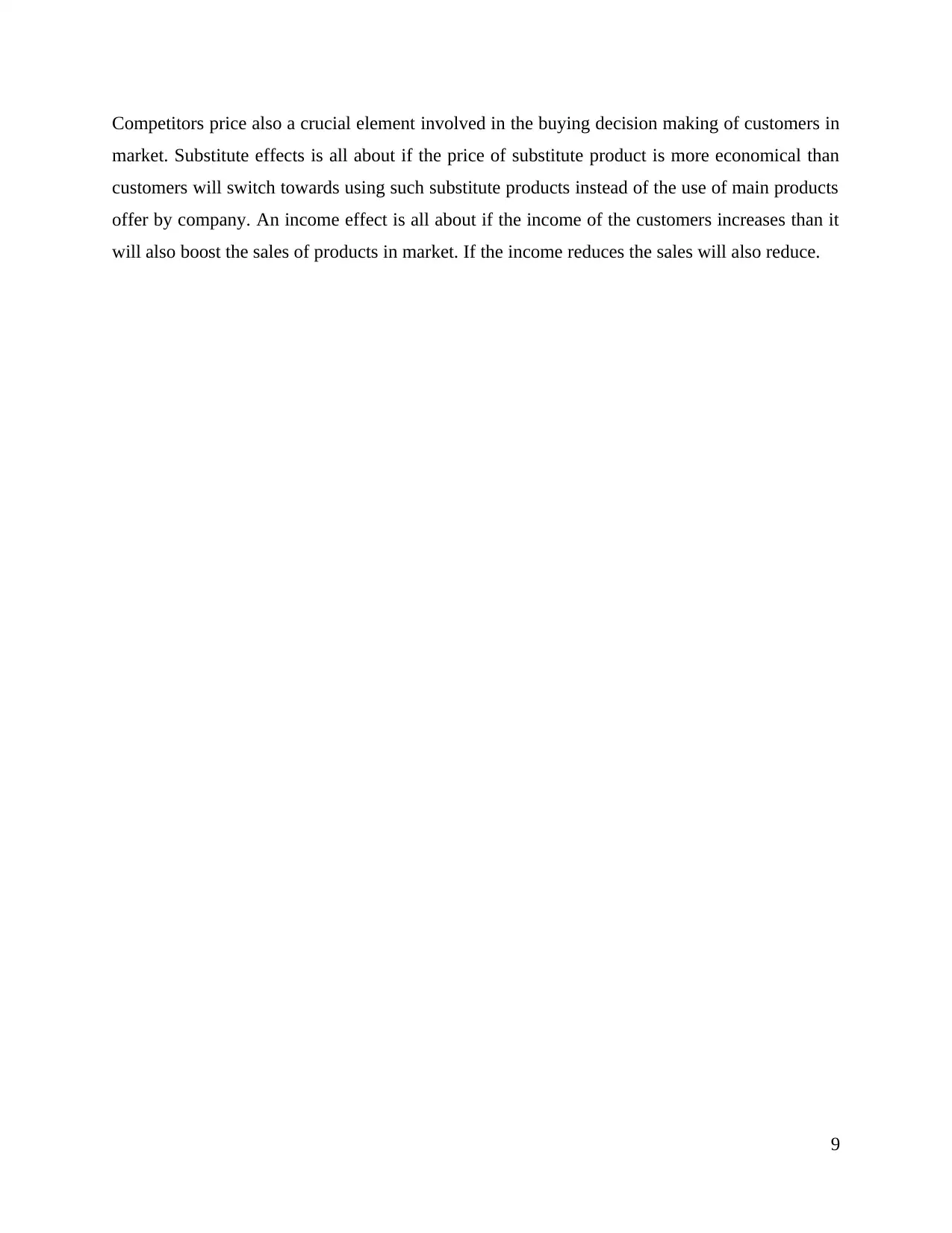
Competitors price also a crucial element involved in the buying decision making of customers in
market. Substitute effects is all about if the price of substitute product is more economical than
customers will switch towards using such substitute products instead of the use of main products
offer by company. An income effect is all about if the income of the customers increases than it
will also boost the sales of products in market. If the income reduces the sales will also reduce.
9
market. Substitute effects is all about if the price of substitute product is more economical than
customers will switch towards using such substitute products instead of the use of main products
offer by company. An income effect is all about if the income of the customers increases than it
will also boost the sales of products in market. If the income reduces the sales will also reduce.
9
⊘ This is a preview!⊘
Do you want full access?
Subscribe today to unlock all pages.

Trusted by 1+ million students worldwide
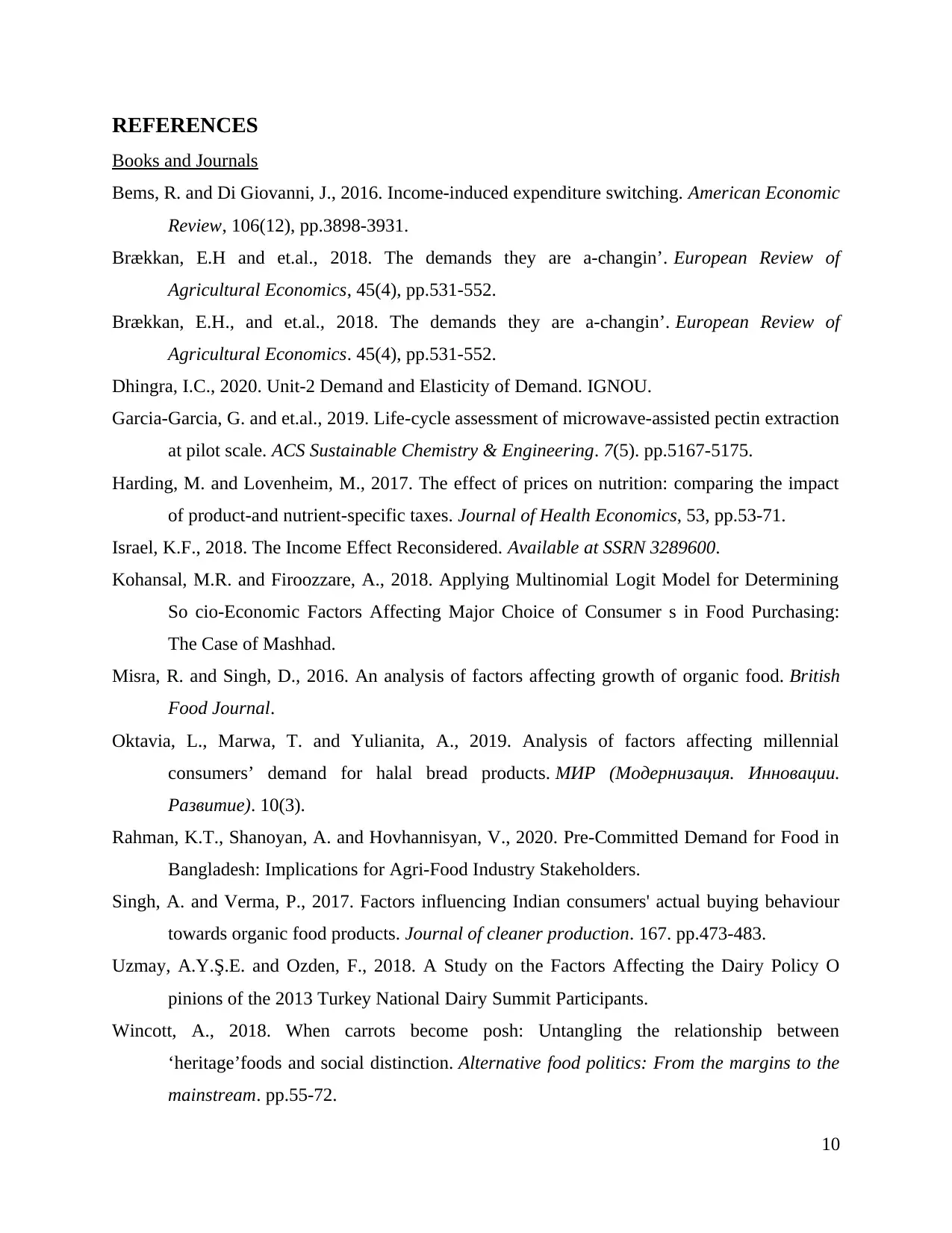
REFERENCES
Books and Journals
Bems, R. and Di Giovanni, J., 2016. Income-induced expenditure switching. American Economic
Review, 106(12), pp.3898-3931.
Brækkan, E.H and et.al., 2018. The demands they are a-changin’. European Review of
Agricultural Economics, 45(4), pp.531-552.
Brækkan, E.H., and et.al., 2018. The demands they are a-changin’. European Review of
Agricultural Economics. 45(4), pp.531-552.
Dhingra, I.C., 2020. Unit-2 Demand and Elasticity of Demand. IGNOU.
Garcia-Garcia, G. and et.al., 2019. Life-cycle assessment of microwave-assisted pectin extraction
at pilot scale. ACS Sustainable Chemistry & Engineering. 7(5). pp.5167-5175.
Harding, M. and Lovenheim, M., 2017. The effect of prices on nutrition: comparing the impact
of product-and nutrient-specific taxes. Journal of Health Economics, 53, pp.53-71.
Israel, K.F., 2018. The Income Effect Reconsidered. Available at SSRN 3289600.
Kohansal, M.R. and Firoozzare, A., 2018. Applying Multinomial Logit Model for Determining
So cio-Economic Factors Affecting Major Choice of Consumer s in Food Purchasing:
The Case of Mashhad.
Misra, R. and Singh, D., 2016. An analysis of factors affecting growth of organic food. British
Food Journal.
Oktavia, L., Marwa, T. and Yulianita, A., 2019. Analysis of factors affecting millennial
consumers’ demand for halal bread products. МИР (Модернизация. Инновации.
Развитие). 10(3).
Rahman, K.T., Shanoyan, A. and Hovhannisyan, V., 2020. Pre-Committed Demand for Food in
Bangladesh: Implications for Agri-Food Industry Stakeholders.
Singh, A. and Verma, P., 2017. Factors influencing Indian consumers' actual buying behaviour
towards organic food products. Journal of cleaner production. 167. pp.473-483.
Uzmay, A.Y.Ş.E. and Ozden, F., 2018. A Study on the Factors Affecting the Dairy Policy O
pinions of the 2013 Turkey National Dairy Summit Participants.
Wincott, A., 2018. When carrots become posh: Untangling the relationship between
‘heritage’foods and social distinction. Alternative food politics: From the margins to the
mainstream. pp.55-72.
10
Books and Journals
Bems, R. and Di Giovanni, J., 2016. Income-induced expenditure switching. American Economic
Review, 106(12), pp.3898-3931.
Brækkan, E.H and et.al., 2018. The demands they are a-changin’. European Review of
Agricultural Economics, 45(4), pp.531-552.
Brækkan, E.H., and et.al., 2018. The demands they are a-changin’. European Review of
Agricultural Economics. 45(4), pp.531-552.
Dhingra, I.C., 2020. Unit-2 Demand and Elasticity of Demand. IGNOU.
Garcia-Garcia, G. and et.al., 2019. Life-cycle assessment of microwave-assisted pectin extraction
at pilot scale. ACS Sustainable Chemistry & Engineering. 7(5). pp.5167-5175.
Harding, M. and Lovenheim, M., 2017. The effect of prices on nutrition: comparing the impact
of product-and nutrient-specific taxes. Journal of Health Economics, 53, pp.53-71.
Israel, K.F., 2018. The Income Effect Reconsidered. Available at SSRN 3289600.
Kohansal, M.R. and Firoozzare, A., 2018. Applying Multinomial Logit Model for Determining
So cio-Economic Factors Affecting Major Choice of Consumer s in Food Purchasing:
The Case of Mashhad.
Misra, R. and Singh, D., 2016. An analysis of factors affecting growth of organic food. British
Food Journal.
Oktavia, L., Marwa, T. and Yulianita, A., 2019. Analysis of factors affecting millennial
consumers’ demand for halal bread products. МИР (Модернизация. Инновации.
Развитие). 10(3).
Rahman, K.T., Shanoyan, A. and Hovhannisyan, V., 2020. Pre-Committed Demand for Food in
Bangladesh: Implications for Agri-Food Industry Stakeholders.
Singh, A. and Verma, P., 2017. Factors influencing Indian consumers' actual buying behaviour
towards organic food products. Journal of cleaner production. 167. pp.473-483.
Uzmay, A.Y.Ş.E. and Ozden, F., 2018. A Study on the Factors Affecting the Dairy Policy O
pinions of the 2013 Turkey National Dairy Summit Participants.
Wincott, A., 2018. When carrots become posh: Untangling the relationship between
‘heritage’foods and social distinction. Alternative food politics: From the margins to the
mainstream. pp.55-72.
10
Paraphrase This Document
Need a fresh take? Get an instant paraphrase of this document with our AI Paraphraser

11
1 out of 11
Related Documents
Your All-in-One AI-Powered Toolkit for Academic Success.
+13062052269
info@desklib.com
Available 24*7 on WhatsApp / Email
![[object Object]](/_next/static/media/star-bottom.7253800d.svg)
Unlock your academic potential
Copyright © 2020–2025 A2Z Services. All Rights Reserved. Developed and managed by ZUCOL.





